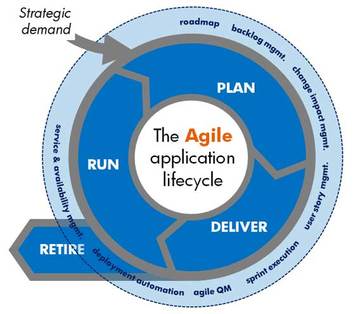Agile software development means that :-
1. All stakeholders accept the fact that all requirements to meet strategic demand & roadmap cannot be fully and clearly understood upfront. These requirements will change and project team especially developers should anticipate and welcome the change as the project progresses.
2. There will be many short releases on weekly/bi-weekly/monthly of small increments (working software features or modules). The short cycle and small increments forces project team and customer to prioritize most valuable/important features, thus enables customers to start using the system much earlier. It also ensures money is spent first on the most important features thus reduces financial risk in case project comes to an abrupt end. The shorter release cycles enables faster customer feedback on the features and greatly reduces risk of misunderstood requirement. The cycle will repeat until all requirements are implemented (all backlogs are cleared).
3. There will be continuous integration and testing at each cycle. Continuous integration and testing forces the increments to fully comply with systems requirements thus reduces any technical risk.
4. Customers have active role to ensure successful completion of the project (successful development and delivery of the software). This is because there will be higher visibility throughout the project. Any deviation can be quickly corrected. Deviation risk is limited to one cycle time whatever it may be weekly/bi-weekly/monthly.
If you need further clarification on agile software development can be adopted by your organization or how it can benefit you, do connect with us.
1. All stakeholders accept the fact that all requirements to meet strategic demand & roadmap cannot be fully and clearly understood upfront. These requirements will change and project team especially developers should anticipate and welcome the change as the project progresses.
2. There will be many short releases on weekly/bi-weekly/monthly of small increments (working software features or modules). The short cycle and small increments forces project team and customer to prioritize most valuable/important features, thus enables customers to start using the system much earlier. It also ensures money is spent first on the most important features thus reduces financial risk in case project comes to an abrupt end. The shorter release cycles enables faster customer feedback on the features and greatly reduces risk of misunderstood requirement. The cycle will repeat until all requirements are implemented (all backlogs are cleared).
3. There will be continuous integration and testing at each cycle. Continuous integration and testing forces the increments to fully comply with systems requirements thus reduces any technical risk.
4. Customers have active role to ensure successful completion of the project (successful development and delivery of the software). This is because there will be higher visibility throughout the project. Any deviation can be quickly corrected. Deviation risk is limited to one cycle time whatever it may be weekly/bi-weekly/monthly.
If you need further clarification on agile software development can be adopted by your organization or how it can benefit you, do connect with us.

 RSS Feed
RSS Feed


